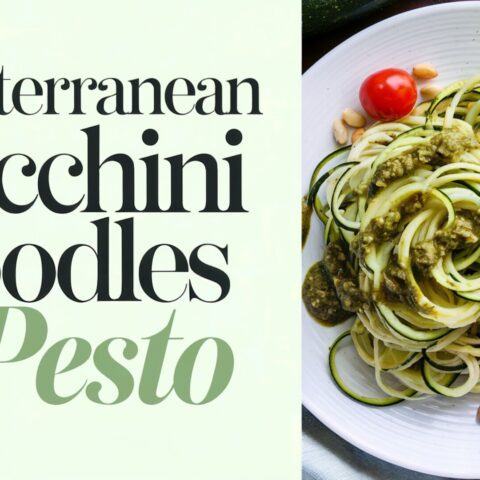
Gluten-free noodles are not automatically low in carbohydrates, as many are made from high-carb ingredients like rice or corn flour. Traditional gluten-free pasta typically contains 40-50 grams of carbohydrates per serving, similar to wheat-based versions. However, some alternatives like chickpea or lentil pasta offer lower net carbs and higher protein content. Careful label reading is essential to identify total carbohydrates and fiber content, enabling informed choices for specific dietary needs. Understanding pasta alternatives opens up a world of nutritious options.
Key Takeaways
- Gluten-free noodles are not necessarily low-carb, as most contain 40-50 grams of carbohydrates per serving, similar to regular pasta.
- Check nutrition labels for total carbohydrates and fiber content to calculate net carbs, which is crucial for low-carb dieting.
- Rice and corn-based gluten-free noodles have high carb content, while legume-based alternatives offer lower net carbs.
- Chickpea pasta contains about 25 grams of net carbs per serving, while lentil pasta can have as low as 11 grams.
- Look for specialized low-carb alternatives like shirataki or zucchini noodles if following a strict low-carb diet.
Understanding Gluten-Free Vs Low-Carb Diets
While both gluten-free and low-carb diets have gained significant popularity in recent years, these dietary approaches serve distinctly different purposes and require separate considerations. For individuals with gluten sensitivities or celiac disease, gluten-free pasta options provide safe alternatives to wheat-based products, regardless of carbohydrate content. In contrast, those following a low-carb diet focus primarily on reducing carbohydrate intake, typically limiting net carbs per serving to maintain specific dietary goals. It's essential to check the nutrition labels when selecting pasta alternatives, as many gluten-free products can contain similar or higher carbohydrate levels compared to traditional wheat pasta. While gluten-free pasta made from rice or corn remains high in carbs, low-carb pasta alternatives like zucchini noodles offer solutions for those pursuing both dietary requirements. For example, many starchy vegetables are high in carbohydrates and should be avoided on a low-carb diet.
The Science Behind Carbohydrates in Pasta
Carbohydrates in pasta undergo complex metabolic processes that affect blood sugar levels and energy provision in the body. When comparing traditional pasta to gluten-free noodles, the carbohydrate content often remains similar, with both varieties averaging 40 to 50 grams per serving. Understanding net carbs becomes essential when evaluating pasta options, particularly for those following low-carb or ketogenic diets. While gluten-free noodles made from rice or corn maintain high carbohydrate levels, legume-based options offer reduced net carbs and increased protein content. To achieve ketosis, individuals must limit carbohydrate intake to 20-50 grams daily, as outlined in the Keto diet, which is stricter than other low-carb diets. To make informed choices, consumers must check nutritional labels carefully, as gluten-free alternatives don't automatically translate to lower carbohydrates. The variation in carbohydrate content among different types of gluten-free pasta emphasizes the importance of ingredient awareness and portion control for effective dietary management.
Common Types of Gluten-Free Noodles
Rice noodles represent a widely available gluten-free option, offering a texture similar to traditional wheat pasta while containing comparable carbohydrate levels of 40-50 grams per serving.
Bean-based alternatives, including chickpea and lentil pasta varieties, provide enhanced nutritional profiles with higher protein and fiber content, while typically containing fewer net carbs than their rice-based counterparts.
These legume-derived options range from chickpea pasta at 25 grams of net carbs per serving to lentil-based varieties at 11 grams, making them suitable choices for those seeking both gluten-free and reduced-carbohydrate alternatives.
Popular Rice Noodle Options
Asian cuisine enthusiasts have long embraced the versatility of gluten-free rice noodles, which come in several distinct varieties to suit different dishes and cooking methods.
While these noodles provide a safe option for those avoiding gluten, they remain high in carbohydrates, typically containing 40-50 grams of net carbs per serving. Health-conscious consumers should carefully review the nutrition label when selecting rice noodles, particularly when following a low-carb diet.
Common rice noodle varieties include:
- Flat rice noodles, perfect for stir-fry dishes like Pad See Ew
- Thin vermicelli noodles, commonly used in Vietnamese pho
- Wide rice noodles, ideal for heartier dishes
For those seeking lower-carb alternatives, some manufacturers now offer modified rice noodles made with alternative ingredients, while options like shirataki or vegetable-based noodles provide additional gluten-free choices.
Bean-Based Pasta Varieties
While traditional pasta remains a dietary staple for many, bean-based pasta varieties have emerged as nutritious alternatives for those seeking gluten-free options with enhanced protein content.
These innovative products offer notable nutritional benefits, particularly regarding protein and fiber content.
Black bean and chickpea pasta each contain approximately 25 grams of net carbs per serving, with chickpea pasta providing about 14 grams of protein.
Edamame pasta stands out as a particularly low-carb option, containing roughly 14 grams of net carbs while delivering an impressive 24 grams of protein per serving.
When selecting bean-based pasta varieties, consumers should carefully review the nutrition label, as carbohydrate content can vary markedly between manufacturers and specific bean types.
Net Carbs: What They Mean for Your Diet
Understanding net carbs in gluten-free noodles requires careful attention to nutritional labels, particularly the total carbohydrates and fiber content.
The calculation is straightforward: subtract the grams of fiber from the total carbohydrates to determine the net carb content that will affect blood sugar levels.
For those following specialized diets like keto or low-carb plans, this calculation becomes essential when selecting gluten-free noodles, as traditional varieties can contain significant net carbs that may exceed dietary limits.
Recognizing serving sizes ensures accurate nutrient tracking, as many packaged foods contain multiple servings.
Calculating Total Net Carbs
For individuals following specialized diets, calculating net carbs provides a more accurate measure of how carbohydrates affect blood sugar levels and weight management goals.
To determine net carbs in gluten-free noodles, subtract the fiber content from total carbohydrates shown on nutritional labels. This calculation is essential for maintaining dietary requirements, especially for those following low-carb diets.
- A serving of gluten-free noodles with 40g total carbohydrates and 5g fiber contains 35g net carbs
- Traditional gluten-free noodles typically contain 35-44g net carbs per serving
- Daily net carb limits range from 20-50g for ketogenic diets and 50-100g for general low-carb diets
Understanding these calculations helps consumers make informed decisions about whether specific gluten-free noodles align with their nutritional goals and carbohydrate restrictions.
Understanding Fiber's Role
The essential relationship between fiber and net carbs plays a fundamental role in determining the true dietary impact of gluten-free noodles.
When examining the nutritional label, consumers must understand that fiber content directly affects the calculation of net carbs, which is vital for those following low-carb diets.
To determine net carbs, one must subtract the fiber content from total carbohydrates, as fiber does not greatly impact blood sugar levels. For those maintaining strict daily carb intake limits between 20-50 grams, this calculation becomes particularly important.
Additionally, the fiber content in gluten-free noodles offers benefits beyond net carb calculations, as it supports digestive health and helps create a feeling of fullness, potentially supporting weight management goals through improved satiety.
Reading Labels Effectively
While maneuvering through nutrition labels on gluten-free noodles may seem intimidating, calculating net carbs requires focusing on two key numbers: total carbohydrates and dietary fiber. Understanding net carbs involves subtracting the fiber content from total carbohydrates to determine the impact on blood sugar levels.
When evaluating gluten-free noodles, consider these important factors:
- Traditional gluten-free noodles made from rice or corn typically contain 35-50 grams of net carbs per serving.
- Specialized gluten-free pastas using low-carb ingredients like chickpeas offer reduced net carbs, ranging from 5-15 grams.
- Serving size markedly impacts calculations, making it essential to note recommended portions.
For those following a low-carb diet, choosing specialized gluten-free pastas made from alternative ingredients can provide better options while maintaining dietary requirements.
Reading Nutrition Labels on Pasta Products
Successfully guiding through nutrition labels on pasta products requires careful attention to several key components, particularly when seeking gluten-free alternatives.
When examining gluten-free noodles, consumers should first locate total carbohydrates, which often range from 35 to 50 grams per serving. To determine net carbs, subtract dietary fiber from the total carbohydrates, a calculation especially important for those following low-carb diets.
The ingredient list reveals the type of flour used, with rice and corn-based options typically containing higher carbohydrate content than those made from chickpeas or lentils.
Careful consideration of serving sizes is essential, as labels may display nutritional information based on smaller portions than commonly consumed. Comparing nutritional information across brands helps identify products that best align with specific dietary requirements.
Best Low-Carb Gluten-Free Pasta Alternatives
Discovering suitable low-carb alternatives to traditional gluten-free pasta requires understanding the diverse options available in the current market. Several innovative products offer considerably lower net carbs while maintaining satisfying texture and taste. Shirataki noodles and zucchini noodles stand out as exceptional low-carb alternatives, containing only 6 and 2 grams of net carbs per serving, respectively.
For those seeking protein-rich options with moderate carbohydrate content, consider:
- Kaizen Lupini Pasta, providing just 6 grams of net carbs per serving
- Chickpea pasta, offering around 11-25 grams of net carbs
- Lentil-based gluten-free pasta, containing similar net carbs to chickpea varieties
These alternatives provide versatility for those following both gluten-free and low-carb dietary patterns, while delivering essential nutrients and maintaining the familiar pasta experience. When selecting low-carb pasta alternatives, it's important to ensure they are rich in healthy fats and essential nutrients to support a balanced ketogenic diet.
Vegetable-Based Noodle Options
As health-conscious consumers embrace alternatives to traditional pasta, vegetable-based noodles have emerged as versatile, nutrient-rich options for those following gluten-free and low-carb diets. Leading the pack are zucchini noodles, containing just 2 grams of net carbs per serving, and spaghetti squash, with approximately 7 grams. These nutritious alternatives are created through spiralizing or roasting vegetables, offering a satisfying pasta experience without gluten. Shirataki noodles, derived from the konjac plant, provide a virtually zero-carb option, while Palmini hearts of palm noodles contain roughly 4 grams of carbs per serving. Beyond their low-carb benefits, these vegetable-based noodles enhance meals with additional fiber and essential nutrients, supporting digestive health and overall wellness. Among the various options, Shirataki noodles stand out due to their versatility and nearly negligible carb content, making them a preferred choice for keto enthusiasts.
Protein Content in Gluten-Free Noodles
Many gluten-free noodles offer varying levels of protein content, with legume-based options emerging as particularly protein-rich alternatives to traditional wheat pasta.
When examining nutrition labels, consumers will find notable differences in protein content across different types of gluten-free noodles.
- Traditional gluten-free noodles made from rice or corn contain modest amounts of protein, typically 4-6 grams per serving.
- Chickpea pasta and other legume-based options provide higher protein content, reaching up to 14 grams per serving.
- Specialized gluten-free pasta brands, such as Banza, maximize protein content with formulations containing up to 25 grams per serving.
For those seeking to maintain adequate protein intake while following a gluten-free diet, legume-based and specialized high-protein options present viable alternatives to conventional gluten-free noodles.
Though protein content varies considerably by brand and ingredient base.
Impact on Blood Sugar Levels
While gluten-free noodles provide a necessary alternative for those with celiac disease or gluten sensitivity, their impact on blood sugar levels requires careful consideration. Many gluten-free pasta options, particularly those made from rice or corn, contain substantial net carbs ranging from 35 to 44 grams per serving, which can markedly affect blood sugar levels.
For individuals managing dietary restrictions or following low-carb diets, legume-based noodles offer a promising solution. These alternatives typically feature a lower glycemic index and higher protein content, helping to stabilize blood sugar responses.
Careful examination of nutrition labels remains essential when selecting gluten-free pasta options, as carbohydrate content varies considerably between products. Moderating portion sizes and choosing lower-carb varieties can help maintain better blood sugar control while accommodating gluten-free requirements.
Portion Control Guidelines
Successful management of gluten-free noodle consumption depends heavily on understanding and implementing proper portion control guidelines. When incorporating these noodles into a diet, carefully monitoring portion sizes is essential, as a standard serving contains between 30 to 50 grams of net carbs.
To maintain healthy carb intake, individuals should carefully review nutrition labels and consider limiting portions to one ounce per meal.
Mindful portion control starts with reading labels and restricting gluten-free noodle servings to one ounce, supporting healthy carbohydrate management.
- Standard portions range from 2-3 ounces, but should be adjusted based on dietary requirements
- Creating balanced meals by combining smaller noodle portions with vegetables and protein
- Maintaining a food diary helps track portion sizes and overall carb consumption
For ideal portion control, measuring servings and tracking daily intake through a food diary enables better management of carb consumption while still enjoying gluten-free noodles as part of a balanced meal plan.
Cooking Techniques for Alternative Pasta
Mastering the proper cooking techniques for alternative pasta varieties requires attention to specific preparation methods that differ from traditional wheat-based noodles.
When preparing gluten-free noodles, using a large pot of salted boiling water helps prevent sticking and enhances flavor. To maintain ideal texture and taste, it's essential to monitor doneness carefully, typically checking after six minutes to avoid mushiness.
Different alternative pasta types require specific approaches. Shirataki noodles benefit from a cold water rinse before cooking, while vegetable-based alternatives like zoodles need quick sautéing to achieve the right texture.
For all varieties, reserving some cooking water proves valuable when combining with sauce, helping maintain proper moisture levels and improving the final dish's consistency.
Storage and Shelf Life
Understanding proper storage techniques for gluten-free noodles is essential for maintaining their quality and extending their usable life span.
Different varieties of gluten-free noodles, from rice-based to legume-based options, have varying shelf lives and storage requirements, with most unopened packages lasting up to two years when kept in cool, dry conditions.
Monitoring for signs of spoilage, such as off-odors, discoloration, or mold growth, helps guarantee the safety and palatability of stored gluten-free pasta products.
Proper Storage Methods
The proper storage of gluten-free noodles plays an essential role in maintaining their quality, texture, and safety for consumption. Understanding correct storage methods can greatly extend shelf life and preserve the low carb properties of these specialty products.
Proper storage includes keeping unopened packages in cool, dry locations away from direct sunlight, while ensuring opened packages are sealed tightly.
- Unopened packages remain fresh for 1-2 years when stored properly, while opened packages should be used within 3-6 months.
- Cooked noodles require refrigeration in airtight containers and should be consumed within 3-5 days.
- Freezing is viable for up to 3 months, with brief blanching recommended before storage.
Always refer to package instructions, as expiration dates and storage recommendations may vary between brands, impacting overall quality and cooking results.
Shelf Life By Type
Storage duration varies greatly among different types of gluten-free noodles, with each variety requiring specific conditions to maintain ideal freshness and quality.
Traditional gluten-free noodles made from rice or corn can last up to two years when stored properly, while those derived from legumes typically maintain quality for six to twelve months.
Once opened, most low-carb alternatives should be consumed within three to six months for best taste and texture.
Specialty options like shirataki noodles offer unique storage considerations, lasting up to a year unopened but requiring refrigeration and quick consumption once opened.
Fresh alternatives such as zucchini noodles have markedly shorter shelf lives of just one to two days.
Consumers should always check the packaging for specific storage instructions and expiration dates, as requirements vary by manufacturer and ingredients.
Signs of Spoilage
Maintaining awareness of spoilage indicators in gluten-free noodles helps consumers prevent foodborne illness and guarantee peak quality.
When examining gluten-free noodles for freshness, consumers should check expiration dates and watch for specific signs that indicate the product has degraded beyond safe consumption.
Key indicators of spoilage include:
- Presence of visible mold or unusual spots on the noodles
- Strong off smell or musty odors when opening the package
- Discoloration or changes in texture from the original appearance
To maximize shelf life and prevent premature spoilage, store unopened packages in cool, dry locations, and transfer opened noodles to airtight containers.
This practice helps maintain freshness by preventing moisture absorption and reducing exposure to environmental contaminants that can accelerate degradation.
Meal Planning With Low-Carb Noodles
Successful meal planning with low-carb noodles requires careful attention to nutritional content and strategic ingredient selection. When developing a low-carb meal plan, consumers should prioritize options like shirataki and zucchini noodles, which contain considerably fewer net carbs than traditional gluten-free alternatives. Regular monitoring of nutrition labels helps maintain dietary goals while incorporating high-protein options like chickpea pasta for enhanced satiety. To ensure a well-rounded diet, it's important to focus on high-quality fats and proteins alongside low-carb noodle alternatives to sustain energy levels and nutrient intake.
| Noodle Type | Net Carbs/Serving | Best Pairings |
|---|---|---|
| Shirataki | 6g | Asian stir-fries |
| Zucchini | 2g | Marinara sauce |
| Chickpea | 25g | Pesto dishes |
| Rice/Corn | 40-50g | Light broths |
To maximize nutritional benefits, combine these low-carb alternatives with vegetables and lean proteins, creating satisfying meals that align with carb-conscious eating patterns.
Budget-Friendly Low-Carb Pasta Choices
Savvy shoppers can find numerous wallet-friendly alternatives to traditional pasta, with options ranging from shirataki noodles at under $3 per package to homemade zucchini noodles costing less than $2 per serving.
Store-brand versions of legume-based and vegetable-based pasta alternatives offer significant savings compared to name-brand products, typically priced between $2 and $3 per package.
Budget-conscious consumers can further reduce costs by watching for sales on specialty items like chickpea pasta and hearts of palm noodles, which frequently drop to around $2.50 per serving while maintaining their low-carb benefits.
Money-Saving Noodle Swaps
While traditional gluten-free noodles can strain both budgets and carb counts, several cost-effective alternatives offer considerably lower carbohydrate content without sacrificing quality or taste.
When checking the label for low-carb alternatives, consumers can find budget-friendly options that dramatically reduce net carbs while maintaining nutritional value.
Consider these wallet-friendly substitutes:
- Zucchini noodles provide just 4 grams of net carbs per serving, offering significant savings compared to conventional gluten-free pasta.
- Shirataki noodles contain less than 1 gram of net carbs and are virtually calorie-free.
- Protein-rich chickpea pasta delivers fiber and nutrients at competitive prices, with approximately 25 grams of net carbs.
Purchasing these alternatives in bulk, especially through online retailers or discount stores, can further maximize savings while maintaining a low-carb lifestyle.
Affordable Pasta Substitutes
Finding affordable low-carb pasta alternatives has become increasingly accessible as the market expands with budget-conscious options that satisfy both dietary needs and financial constraints.
Several gluten-free, low-carb substitutes offer excellent value while keeping net carbs in check. Zucchini noodles contain only 4 grams of net carbs per serving and are cost-effective when prepared at home, while shirataki noodles provide a virtually carb-free option for under $3 per package.
Spaghetti squash presents another economical choice at less than $5, containing just 7 grams of net carbs per serving.
For those seeking protein-rich alternatives, red lentil and chickpea pasta options range from $3 to $5 per package, offering varying levels of net carbs while delivering substantial nutritional benefits.
Combining Pasta Alternatives in Recipes
Combining different types of gluten-free and low-carb pasta alternatives creates opportunities for delicious, nutritionally balanced meals that accommodate dietary restrictions.
By mixing ingredients like chickpea pasta with zucchini noodles or palmini hearts of palm, individuals can maintain traditional pasta textures while reducing net carbs considerably.
Red lentil pasta combined with spiralized vegetables offers enhanced nutritional benefits through increased fiber and protein content.
- Blend chickpea pasta (25g net carbs per serving) with vegetable noodles to maintain flavor while reducing overall carbohydrates
- Incorporate palmini hearts of palm noodles (4g carbs per serving) alongside gluten-free pasta for balanced meals
- Mix red lentil pasta (11g net carbs per serving) with spiralized vegetables to boost fiber and protein content
Careful attention to nutrition labels guarantees accurate tracking of carbohydrates when experimenting with these pasta alternatives.
Frequently Asked Questions
Are Gluten-Free Noodles Low-Carb?
Gluten free noodles vary noticeably in carbohydrate content based on their ingredients. While some noodle varieties like shirataki offer low carb options, most gluten free diets require checking nutrition labels for dietary preferences.
Is Gluten-Free Considered Low-Carb?
Gluten-free products made from grains often contain high carbohydrates. Carb counting and nutrition labels reveal that gluten-free dietary restrictions focus on wheat protein elimination rather than providing specific health benefits for meal planning.
What Is the Difference Between Labeled Gluten-Free and Certified Gluten-Free?
Labeled gluten-free products follow basic labeling regulations, while certified gluten-free undergoes rigorous certification processes, ingredient sourcing verification, and gluten detection testing to meet strict standards, ensuring greater consumer safety and health protection.
Which Noodle Is Lowest in Carbs?
Among alternative noodle options, zucchini noodles contain the lowest carb content at 2 grams per serving, followed by shirataki noodles at 6 grams, making them superior to cauliflower gnocchi or lentil varieties.
Conclusion
While gluten-free noodles may be suitable for those with celiac disease or gluten sensitivity, they aren't necessarily low in carbohydrates. Many gluten-free pasta alternatives, made from rice, corn, or quinoa, can contain similar or higher carb counts than traditional wheat pasta. For truly low-carb options, consumers should carefully examine nutrition labels and consider alternatives like shirataki noodles, zucchini spirals, or konjac-based products, which provide substantially fewer net carbs per serving.









No Comments